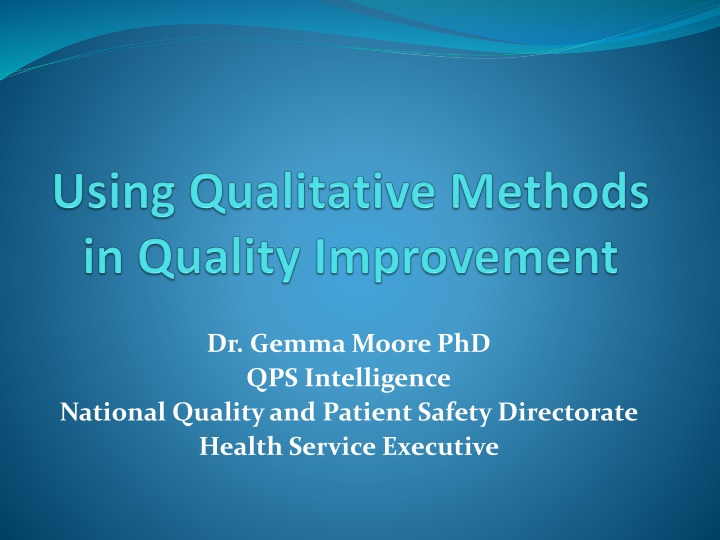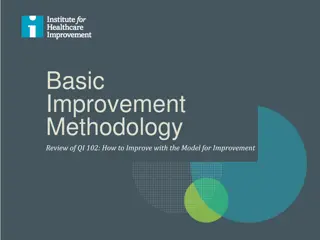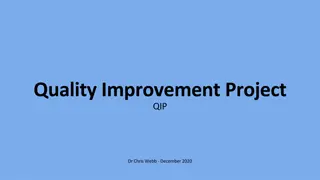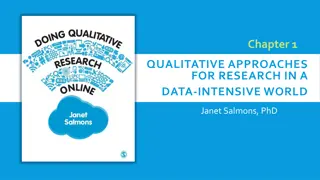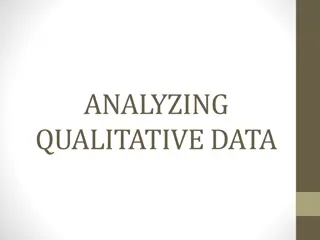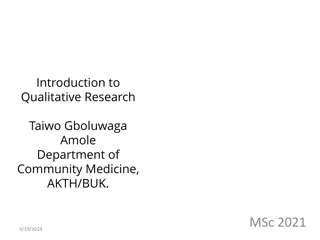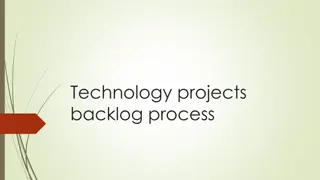Using Qualitative Methods in Quality Improvement Projects
Qualitative methods offer valuable insights in quality improvement projects by capturing non-numerical information like experiences, thoughts, and perspectives. They help to understand patient and staff perspectives, challenges, and successes in QI initiatives. Utilizing techniques such as interviews, focus groups, and observation, qualitative methods can be applied from conceptualization to evaluation stages of improvement projects.
Download Presentation

Please find below an Image/Link to download the presentation.
The content on the website is provided AS IS for your information and personal use only. It may not be sold, licensed, or shared on other websites without obtaining consent from the author.If you encounter any issues during the download, it is possible that the publisher has removed the file from their server.
You are allowed to download the files provided on this website for personal or commercial use, subject to the condition that they are used lawfully. All files are the property of their respective owners.
The content on the website is provided AS IS for your information and personal use only. It may not be sold, licensed, or shared on other websites without obtaining consent from the author.
E N D
Presentation Transcript
Dr. Gemma Moore PhD QPS Intelligence National Quality and Patient Safety Directorate Health Service Executive
Outline What are Qualitative Methods? When to use in QI projects? Steps using Qualitative Methods Determine Purpose Choose your Sample Size and Participants Choose Appropriate Method Determine Questions or Topic Guide Gain Informed Consent Gather Data Analyse your Data: Thematic Analysis Present your results 1. 2. 3. 4. 5. 6. 7. 8.
Qualitative Methods Non-numerical information gathered to capture and understand people's experiences, thoughts, ideas & perspectives Best way to capture patient and staff perspectives and voice Interviews Focus Groups Visual Methods Qualitative Methods Documentary Analysis Observation
Using Qualitative Methods in QI Ideally used at all stages of improvement interventions from conceptualisation, implementation and evaluation Useful for capturing insights into the story or context behind quality improvement work and numerical measurement data Eg. The challenges associated with a QI project Eg. What worked well or what didn t work? Eg. Considerations for sustaining and spreading
1. Determine Purpose Determine what you are trying to find out more about: Ideas for QI projects Capture patient or staff perspective, voice or story Understand the context behind quality improvement work Find out more about numerical measurement data The challenges and enablers associated with a QI projects The impact of a QI project
2. Choose Sample Size and Participants Sample size determined by purpose of the project, time, resources, sample accessibility or when data saturation is reached A small number of in-depth interviews or focus groups will gather a large amount of rich data 3 main types of sampling: Purposive Sampling 1. Sample chosen who fit criteria relevant to the purpose 2. Quota Sampling Takes into account percentage of sample population 3. Snowball or Chain-Referral Sampling Participants refer on to their contacts
3. Choose Appropriate Method Interviews Focus Groups Visual Methods Qualitative Methods Documentary Analysis Observation
Qualitative Methods and QI Face-to-Face, Telephone or Video Call interviews following a set of pre-determined questions provide rich insights through in-depth discussion Focus groups led by a facilitator are useful way for teams to discuss what went well, what didn t go so well, learnings and opportunities for improvement in their QI projects Observing a real situation can help to identify potential QI projects or understand any challenges associated with QI work is in real situations
Interview Types Face-to-Face, Telephone or Video Call Tape record with participant s permission and/or take notes Unstructured 1. Focus on a broad area for discussion Semi-Structured 2. Common set of questions for each interview Flexibility re order of questions Follow up on topics that emerge Structured or Focused Interview 3. Identical set of questions for each interview asked in the same order Interviews provide rich insights through in-depth discussion
Focus Groups A type of group interview, typically tape or video recorded (with permission) seeking to generate discussion among the group Usually 5 to 13 participants (ideal = 6-8) Typically less than 1 hour in length Facilitator can follow a set of questions or topic guide Can include tasks for the group to complete eg. ranking/prioritising a list, buzz groups, etc. Focus groups useful way for teams to discuss their QI work to find out what went well, what didn t go so well, learnings and opportunities for improvement
Facilitating Focus Groups Encourage members of the group interact Discussion stays focused on the topics Managing the discussion Don t lead or influence the discussion Aware of the group dynamics Time management Ensure all members participate Managing disagreements Facilitating tasks
Interview Skills Sensitivity to Interviewer/ee Interaction Researching up, across or down ? Establishing Rapport Without affecting neutrality Listening Attentively without Passing Judgement Purpose of interview to hear participant s perspective, experience and views Re-Focusing and Mainlining Control If going off topic given limited time Use of Probes To illicit further information & get examples Learning the Language Sensitive to cultural setting and discourse commonly used Non-Verbal Messages Participant's body language if uncomfortable with a question Expressions of understanding and interest, echoing their words, summarizing Encouraging Responses Encouraging Responses Non- Verbally To not interrupt - eye contact, head nodding, um huh Flexibility To adapt to what emerges during the interview
Observation Observation is the act of observing a real situation and recording events as they happen Can provide detailed rounded picture of phenomena or situation Data recorded in situ Rich data collected Can help to identify potential QI projects or understand any challenges associated with QI work is in real situations
Other Methods Narratives or Stories Document Analysis Participant Diaries Participant Photos
4. Write Questions or Topic Guide Questions should help you answer your purpose Develop questions in consultation with subject matter experts such as patients, clinicians and other staff Determine whether different questions are required for different participants Develop open questions to encourage discussion Test out questions with some colleagues to ensure they are easy to understand
Open Questions Can you tell me about...? When did you notice...? Why do you think that happened...? What do you think...? How did you know...? What happened then...? Did that affect....? How did you feel...? What impact did that have on....? Who else was there, What did you see as the main...? Where was that....? What did you think....?
5. Gain Informed Consent Invite participants to take part voluntary informed participation Provide information on the purpose of the interview, focus group etc Explain how their data will be used, stored and who will view it Provide a consent form they can sign Provide opportunity for them to ask questions Supply contact details so the can contact you at a later date
6. Gather Data Arrange interview or focus group at a time and location convenient for participants Ensure rooms are accessible for participants or travel to a location suitable for their requirements Tape or video record when possible, or take notes As soon as possible afterwards, make notes of what you remember and things you would like to follow up with other participants
7. Analyse Data Thematic Analysis Read through data to become familiar 1. Make notes/memos of your thoughts as you go 2. Start developing initial codes 3. Refine codes as analysis progresses 4. Sort codes into groups or categories 5. Refine into themes 6.
8. Report Qualitative Findings Write up your analysis using quotes to illustrate
Thank You! Email: gemma.moore2@hse.ie
